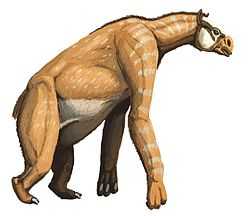Chalicotheriinae
| Chalicotheriinae Temporal range: Late Miocene to Early Pliocene | |
|---|---|
 | |
| Anisodon grande, formerly Chalicotherium grande | |
| Conservation status | |
| Fossil | |
| Scientific classification | |
| Kingdom: | Animalia |
| Phylum: | Chordata |
| Class: | Mammalia |
| Order: | Perissodactyla |
| Suborder: | †Ancylopoda |
| Superfamily: | †Chalicotherioidea |
| Family: | †Chalicotheriidae |
| Subfamily: | †Chalicotheriinae Holland and Peterson, 1914 |
| Genera | |
| |
Chalicotheriines make up an extinct subfamily of the family Chalicotheriidae, a group of herbivorous, odd-toed ungulate (perissodactyl) mammals. Characteristic of this group is an unusual, gorilla-like body plan with very long forelimbs, short hindlimbs, and a partial knuckle-walking position. Analysis of dental microwear implies most chalicotheriines fed on hard fruit and/or seeds. Their claws were most likely used in a hook-like manner to pull down branches, suggesting they lived as bipedal browsers. Presence of chalicotheriine fossils is generally regarded as an indicator of treed environments.[1]
References
- ↑ Coombs, Margery C. (13 Feb 2009). "The chalicothere Metaschizotherium bavaricum (Perissodactyla, Chalicotheriidae, Schizotheriinae) from the Miocene (MN5) Lagerstatte of Sandelzhausen (Germany): description, comparison, and paleoecological significance". Paläontologische Zeitschrift (Springer Berlin / Heidelberg) 83 (1): 85–129. doi:10.1007/s12542-009-0004-x. Retrieved 2009-12-29.